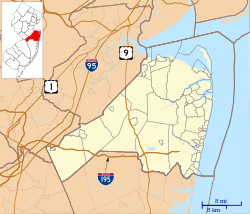Hankinson–Moreau–Covenhoven House
Covenhoven House | |
 | |
| Location | 150 West Main Street, Freehold, New Jersey |
|---|---|
| Coordinates | 40°15′7″N 74°17′19″W / 40.25194°N 74.28861°W |
| Area | 1 acre (0.40 ha) |
| Built | 1752–53 |
| Architect | William Covenhoven |
| NRHP reference No. | 74001175[1] |
| NJRHP No. | 1976[2] |
| Significant dates | |
| Added to NRHP | May 1, 1974 |
| Designated NJRHP | September 14, 1973 |
Covenhoven House is located in Freehold Borough, Monmouth County, New Jersey, United States. The house was built in 1752–53 by William and Elizabeth Covenhoven. The builder of the historic Old Tennent Church was retained for the job, and began work right after the completion of the church. In 1778, General Henry Clinton occupied this house as his headquarters from June 26 to the morning of June 28th, prior to the Battle of Monmouth that day.
Clinton chose the house because it was clearly the finest home in the area. When he arrived there, he realized that Mrs. Covenhoven had already prepared for their visit. The house was devoid of the fine furnishings one would expect in such a home. The valuables had been hidden away in the woods, and the silver and china had been buried in the yard under some rose bushes. Clinton convinced Mrs. Covenhoven that her fine things would not be safe in the woods. If she returned them to the home, he said, they would be under the protection of the British army. She finally acquiesced, and the hidden wagon load was brought back to the house. According to a complaint she filed with the courthouse, she stated that once the wagon arrived, she was not allowed to bring anything inside the home. By morning, the entire wagon had been thoroughly ransacked, and virtually everything was pilfered except for a few insignificant items. One small act of mercy from Clinton was that he refrained from destroying the home; unlike the army, which had burned down several homes in the immediate area.
Covenhoven House added to the National Register of Historic Places on May 1, 1974. The house is one of several houses owned and operated as a historic house museum by the Monmouth County Historical Association.
References[edit]
- ^ "National Register Information System". National Register of Historic Places. National Park Service. March 13, 2009.
- ^ "New Jersey and National Registers of Historic Places – Monmouth County" (PDF). New Jersey Department of Environmental Protection – Historic Preservation Office. April 1, 2010. p. 12. Archived from the original (PDF) on June 4, 2011. Retrieved July 9, 2010.
External links[edit]
- Monmouth County Historical Association
- Historic American Buildings Survey (HABS) No. NJ-227, "General Clinton Headquarters, West Main Street, West Freehold", 6 photos, 20 measured drawings, 4 data pages, supplemental material
- https://monmouthhistory.org/visit/historic-houses/#covenhoven-house
- http://tourism.visitmonmouth.com/covenhoven-house/
- https://revolutionarynj.org/places/covenhoven-house/
- https://www.journeythroughjersey.com/sites/covenhoven-house/
- https://www.visitnj.org/nj-historic-sites-memorials/covenhoven-house
- Freehold Borough, New Jersey
- Historic house museums in New Jersey
- Houses completed in 1706
- Houses in Monmouth County, New Jersey
- Houses on the National Register of Historic Places in New Jersey
- Museums in Monmouth County, New Jersey
- National Register of Historic Places in Monmouth County, New Jersey
- 1706 establishments in New Jersey
- New Jersey Register of Historic Places
- Historic American Buildings Survey in New Jersey
- New Jersey Registered Historic Place stubs
- Northeastern United States museum stubs
- New Jersey building and structure stubs




